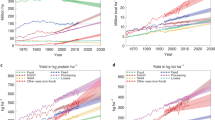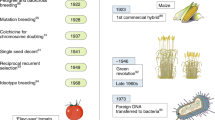Abstract
Solutions to the problem of how the developing world will meet its future food needs are broader than producing more food, although the successes of the 'Green Revolution' demonstrate the importance of technology in generating the growth in food output in the past. Despite these successes, the world still faces continuing vulnerability to food shortages. Given the necessary funding, it seems likely that conventional crop breeding, as well as emerging technologies based on molecular biology, genetic engineering and natural resource management, will continue to improve productivity in the coming decades.
This is a preview of subscription content, access via your institution
Access options
Subscribe to this journal
Receive 51 print issues and online access
$199.00 per year
only $3.90 per issue
Buy this article
- Purchase on Springer Link
- Instant access to full article PDF
Prices may be subject to local taxes which are calculated during checkout




Similar content being viewed by others
References
World Bank. World Development Report, 2000 (World Bank, Washington DC, 2000).
Sen, A. K. On economics of life and death. Sci. Am. 5, 40–47 (1993).
Pingali, P. L., Hossain, M. & Gerpacio, R. V. Asian Rice Bowls (CAB International, Wallingford,, 1997).
Pachico, D., Hertford, R. & de Janvry, A. Assessing the impact of agricultural research on poverty alleviation. Food Policy 25, 379–388 (2000).
Pinstrup-Anderson, P., Pandya-Lorch, R. & Rosegrant, M. W. World Food Prospects: Critical Issues for the Early Twenty-first Century. 2020 Vision Food Policy Report (International Food Policy Research Institute, Washington DC, 1999).
Rosegrant, M. W., Leach, N. & Gerpacio, R. V. Alternative futures for world cereal and meat consumption. Proc. Nutr. Soc. 58, 219–234 (1999).
Byerlee, D., Heisey, P. & Pingali, P. L. in Food Needs of the Developing World in the Early Twenty First Century 207–250 (Pontifical Academy of Sciences, Vatican City, 2000).
Huang, J., Rozelle, S. D. & Rosegrant, M. W. China's food economy to the 21st century: supply, demand, and trade. Econ. Dev. Cult. Change 47, 737–766 (1999).
Pray, C. E. The green revolution: extensions, institutions, impacts and lessons. Department of Agriculture, Food, and Resource Economics Working Paper (Rutgers University, New Brunswick, NJ, 1998).
Pingali, P. L. in Agricultural Technology: Policy Issues for the International Community (ed. Anderson, J. R.) 384–401 (CAB International, Wallingford, 1994).
Morris, M. L. & Byerlee, D. in Agricultural Development: the Third World 3rd edn (eds Eicher, C. K. & Staatz, J.) 458–473 (Johns Hopkins Press, Baltimore, MD, 1998).
Cassman, K. G. & Pingali, P. L. in Agricultural Sustainability: Economic, Environmental and Statistical Considerations (eds Barnett, V., Payne, R. & Steiner, R.) 63–84 (Wiley, New York, 1995).
Huang, J. & Rozelle, S. D. Environmental stress and grain yields in China. Am. J. Agric. Econ. 77, 246–256 (1995).
Cassman, K. G. et al. Opportunities for increased nitrogen use for improved resource management in irrigated rice systems. Field Crop Res. 56, 7–39 (1998).
Ali, M. & Byerlee, D. Productivity growth and resource degradation in Pakistan's Punjab: a decomposition analysis. Econ. Dev. Cult. Change (in the press).
Murgai, R., Ali, M. & Byerlee, D. Productivity growth and sustainability in post-green revolution agriculture: the case for the Indian and Pakistan Punjabs. World Bank Res. Observ. 16, 199–218 (2001).
World Bank. World Development Report, 1992 (World Bank, Washington DC, 1992).
Barker, R., Herdt, R. W & Rose, B. Rice Economy of Asia (Resources For the Future, Washington DC, and International Rice Research Institute, Los Baños, Laguna, Philippines, 1985).
Evenson, R. E., Herdt, R. W. & Hossain, M. Rice Research in Asia: Progress and Priorities (CAB International, Wallingford, 1996).
Pingali, P. L. & Rola, A. C. Public Regulatory Roles in Developing Markets: The Case of Pesticides (International Rice Research Institute, Los Baños, Laguna, Philippines, 1994).
Antle, J. M. & Pingali, P. L. Pesticides, productivity and farmer health: a Philippine case study. Am. J. Agric. Econ. 76, 418–430 (1994).
Fan, S., Hazell, P. B. R. & Thorat, S. Linkages between Government Spending, Growth and Poverty in Rural India Res. Rep. No. 110 (International Food Policy Research Institute, Washington DC, 1999).
Fan, S., Zhang, L. & Zhang, X. Growth, Inequality, and Poverty in Rural China: The Role of Public Investments Res. Rep. No. 125 (International Food Policy Research Institute, Washington DC, 2002).
Huang, Q., Rozelle, S. D., Huang, J. & Wang, J. Irrigation and yields in China's agriculture. Department of Agricultural and Resource Economics Working Paper (Univ. California, Davis, 2002).
Seckler, D., Molden, D. & Barker, R. Water Scarcity in the 21st Century (International Water Management Institute, Colombo, 1998).
Virmani, S. S., Khush, G. S. & Pingali, P. L. in Hybrid Research and Development Needs in Major Cereals in the Asia-Pacific Region (eds Paroda, R. S. & Rai, M) 61–86 (Food and Agriculture Organization of the United Nations, Regional Office for Asia and the Pacific, Bangkok, 1994).
Huang J. & Rozelle, S. D. Technological change: rediscovering of the engine of productivity growth in China's rural economy. J. Dev. Econ. 49, 337–369 (1996).
Yuan L. & Lu, X. Two-line rice hybridization technology and intermedium test development program. Biol. Eng. Prog. 20, 2–6 (2000). [In Chinese.]
Khush, G. S. Modern varieties: their real contribution to food supply and equity. Geojournal 35, 275–284 (1995).
David, C. C. & Otsuka, K. Modern Rice Technology and Income Distribution in Asia. (International Rice Research Institute, Los Baños, Laguna, Philippines, and Lynne Rienner Publishers, Boulder and London, 1994).
James, C. A. Global Status of Commercialized Transgenic Crops, 1999 ISAAA Briefs No. 17-2000 (International Service for the Acquisition of Agri-biotech Applications, Ithaca, NY, 2000).
James, C. A. Global Review of Commercialized Transgenic Crops, 2001 ISAAA Briefs No. 23-2001 (International Service for the Acquisition of Agri-biotech Applications, Ithaca, NY, 2001).
Qaim, M. & Traxler, G. S. Roundup-Ready soybeans in Argentina: farm level, environmental, and welfare effects. International Conference on Agricultural Biotechnology Research, Ravello, Italy, 11-14 July 2002 〈http://www.economia.uniroma2.it/conferenze/icabr/abstract/Qaim.htm〉 (2002).
Huang, J., Rozelle, S. D, Pray, C. E. & Wang, Q. Plant biotechnology in China. Science 295, 674–677 (2002).
Traxler, G., Godoy-Avila, S., Falck-Zepeda, J. & Espinoza-Arellano, J. Transgenic cotton in Mexico: economic and environmental impacts. Department of Agricultural Economics Working Paper (Auburn Univ., Auburn, AL, 2001).
Ismael, Y. Smallholder adoption and economic impacts of Bt cotton in the Makhathini Flats, Republic of South Africa. Report for DFID Natural Resources Policy Research Programme, Project R7946 (Department for International Development, London, 2001).
Huang, J., Wang, Q. & Zhang, Y. Agricultural biotechnology development and research capacity. Center for Chinese Agricultural Policy Working Paper (Center for Chinese Agricultural Policy, Chinese Academy of Sciences, Beijing, 2001).
Pray, C. E. & Schimmelpfennig, D. E. Role of biotech in South Africa's agriculture. Department of Agriculture, Food and Resource Economics Working Paper (Rutgers University, New Brunswick, NJ, 2001).
Pray, C. E., Courtmanche, A. & Govindasamy, R. The importance of intellectual property rights in the international spread of private sector agricultural biotechnology. International Conference on Agricultural Biotechnology Research, Ravello, Italy, 11-14 July 2002 〈http://www.economia.uniroma2.it/conferenze/icabr/abstract/Pray1.htm〉 (2002).
Ekboir, J. (ed.) World Wheat Overview and Outlook 2000-2001: Developing No-Till Packages for Small-Scale Farmers (International Maize and Wheat Improvement Center (CIMMYT), Mexico, 2001).
Khanna, M., Epouhe, O. F. & Hornbaker, R. Site-specific crop management: adoption patterns and incentives. Rev. Agric. Econ. 21, 455–472 (1999).
Alston, J. M., Pardey, P. G. & Roseboom, J. Financing agricultural research: international investment patterns and policy perspectives. World Dev. 26, 1057–1072 (1998).
Pardey, P. G. & Beintema, N. M. Slow Magic: Agricultural R& D A Century after Mendel (International Food Policy Research Institute, Washington DC, 2001).
Alston, J. M., Marra, M. C., Pardey, P. G. & Wyatt, T. J. Research returns redux: a meta-analysis of rates of return to agricultural R&D. Aust. J. Agric. Resource Econ. 44, 185–215 (2000).
Huffman, W. E. & Evenson, R. E. Science for Agriculture: A Long-Term Perspective (Iowa State Univ. Press, Ames, 1993).
Pray, C. E. Public/private sector linkages in research and development: biotechnology and the seed industry in Brazil, China and India. Am. J. Agric. Econ. 83, 742–747 (2001).
Pray, C. E. & Umali-Deininger, D. Private agricultural research: Will it fill the gap? World Dev. 26, 1127–1148 (1998).
Jin, S., Huang, J., Hu, R. & Rozelle, S. D. The creation and spread of technology and total factor productivity in China. Am. J. Agric. Econ. (in the press).
Evenson, R. E. & Gollin, D. A Comprehensive assessment of the role of the CG system in increasing yields in developing countries. Economic Growth Center Working Paper (Yale Univ. Growth Center, New Haven, CT, 2001).
Serageldin, I. & Persley, G. J. Promethian Science: Agricultural Biotechnology, the Environment, and the Poor (Consultative Group on International Agricultural Research, Washington DC, 2000).
Author information
Authors and Affiliations
Corresponding author
Rights and permissions
About this article
Cite this article
Huang, J., Pray, C. & Rozelle, S. Enhancing the crops to feed the poor. Nature 418, 678–684 (2002). https://doi.org/10.1038/nature01015
Issue Date:
DOI: https://doi.org/10.1038/nature01015
This article is cited by
-
Industrialization, Freight Transport and Environmental Quality: Evidence from Belt and Road Initiative Economies
Environmental Science and Pollution Research (2020)
-
Agricultural practices and quality of environment: evidence for global perspective
Environmental Science and Pollution Research (2019)
Comments
By submitting a comment you agree to abide by our Terms and Community Guidelines. If you find something abusive or that does not comply with our terms or guidelines please flag it as inappropriate.



